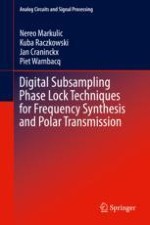2019 | Buch
Digital Subsampling Phase Lock Techniques for Frequency Synthesis and Polar Transmission
verfasst von: Nereo Markulic, Kuba Raczkowski, Jan Craninckx, Piet Wambacq
Verlag: Springer International Publishing
Buchreihe : Analog Circuits and Signal Processing
